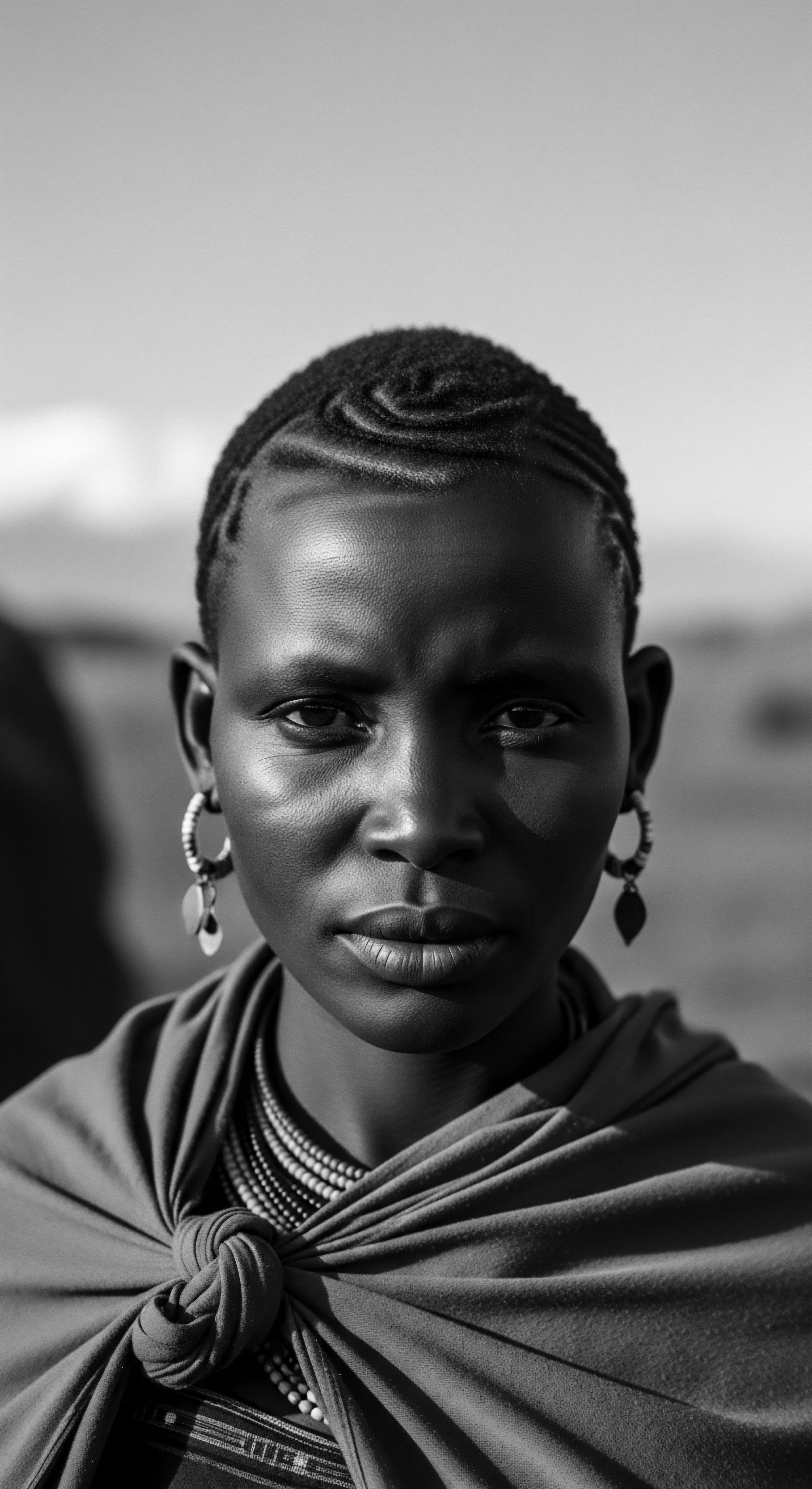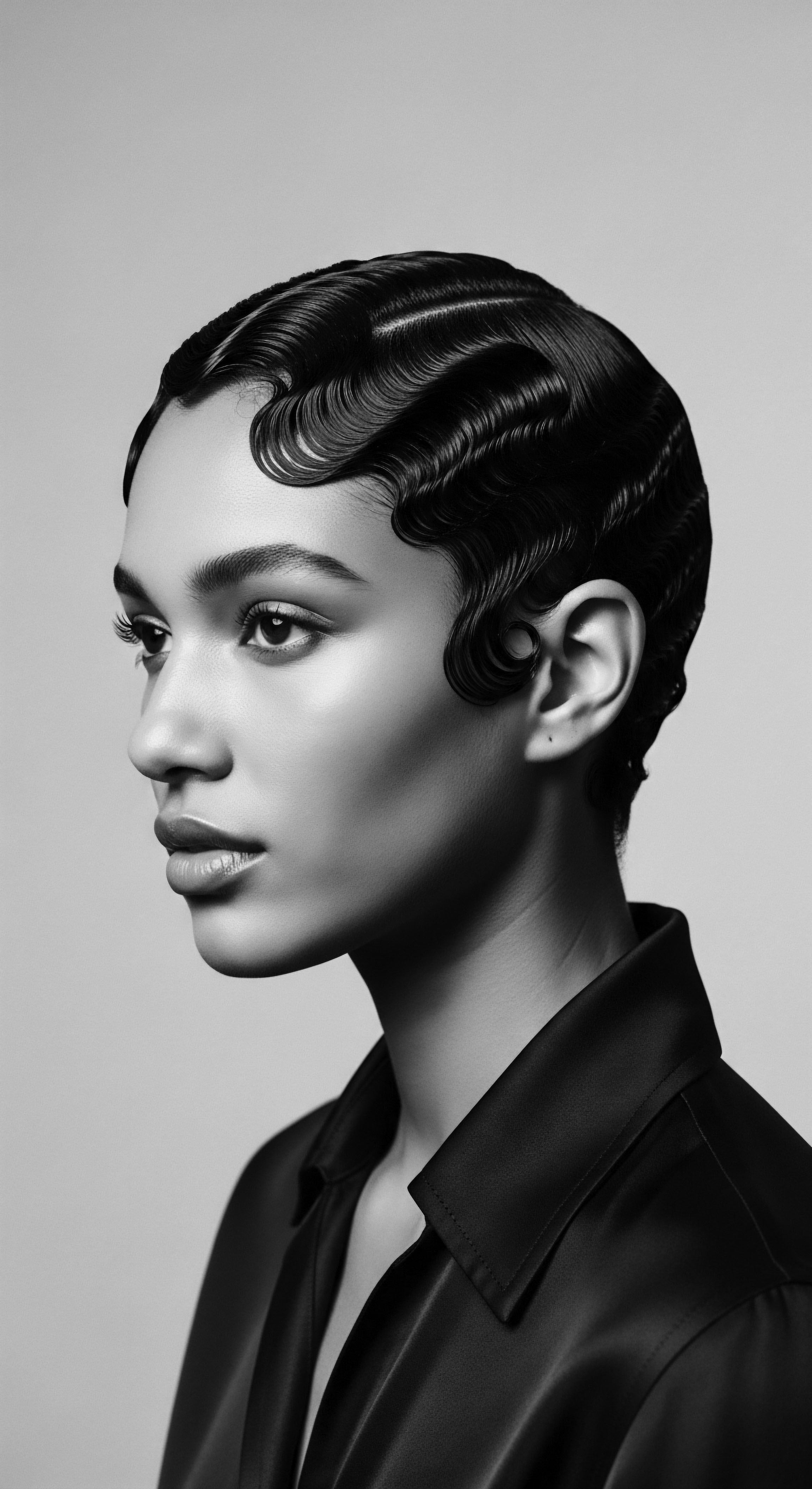
Fundamentals
The concept of Archaeological Discovery, when considered through the sacred lens of textured hair heritage, transcends the mere unearthing of ancient objects. It stands as a profound revelation, an act of listening to the whispers of our ancestors through the tangible echoes they left behind. For those who honor Black and mixed-race hair traditions, this discovery is about more than just finding a relic; it is a moment of profound recognition, a flash of insight that connects the present with the vibrant ingenuity of the past. It speaks to the enduring legacy of hair care, styling, and adornment as central pillars of identity, communication, and spiritual practice across millennia.
At its fundamental expression, an Archaeological Discovery concerning textured hair involves the retrieval and initial recognition of physical evidence from historical or prehistoric contexts. This evidence might manifest as ancient tools crafted for hair maintenance, like meticulously carved combs or intricate hairpins fashioned from bone, wood, or metal. It can also encompass remnants of hair itself, preserved through remarkable circumstances—mummified strands retaining their coiled form, or hair found within ancient tombs, offering direct biological insights into ancestral curl patterns and textures.
Beyond the tools and strands, discoveries often include visual representations ❉ frescoes depicting elaborate hairstyles in ancient Nubia, sculptures showcasing braided artistry from West African kingdoms, or even simple pottery shards bearing imprints that hint at the complex coiffures of their creators. These initial findings offer a foundational understanding, providing the first tangible link to the hair traditions that flourished long before us.
Archaeological Discovery, for textured hair heritage, is the profound act of uncovering physical evidence that illuminates ancestral practices and the enduring significance of hair as a cultural and biological cornerstone.
The immediate purpose of such a discovery is often to identify and classify these artifacts, placing them within a chronological and geographical context. When an archaeologist carefully extracts a fossilized scalp from a burial site, for example, the first step is to establish its age and the cultural group it belonged to. This preliminary understanding allows us to begin piecing together the timeline of hair practices, tracing the evolution of techniques, materials, and cultural meanings.
It helps us discern how ancient communities managed their hair, whether for daily sustenance, ceremonial rites, or expressions of social standing. The initial act of discovery sets the stage for a deeper exploration, inviting us to ponder the lives, beliefs, and artistic expressions woven into each strand and artifact.

Unearthing Ancient Tools and Adornments
Among the most common and compelling archaeological discoveries related to hair are the implements used for its care and styling. These range from simple, practical tools to highly decorative ornaments, each speaking volumes about the daily routines and aesthetic values of past societies.
- Combs ❉ Hand-carved combs from bone, ivory, or wood, some intricately decorated, have been found in various ancient African settlements. These often feature wide-set teeth, a design perfectly suited for detangling and shaping textured hair, suggesting a continuous lineage of understanding about its unique needs.
- Hairpins ❉ Ornate hairpins made from precious metals, copper, or even carved stone, served both functional and symbolic roles. They secured elaborate styles and often signified status, tribal affiliation, or rites of passage within communities.
- Hair Ornaments ❉ Beads, cowrie shells, metal rings, and other adornments discovered in burial sites or everyday contexts demonstrate the profound cultural significance of hair as a canvas for self-expression and community identity. These finds tell us about ancient fashion, but also about trade routes, spiritual beliefs, and social hierarchies.
These primary findings offer immediate insights into the physical application of hair care and styling. They show us not just what was done, but how it was achieved, providing tangible evidence of ancient dexterity and artistry. The very act of finding a well-preserved ancient comb, perhaps still retaining traces of hair or natural oils, offers a quiet conversation across time, connecting our hands to the hands of those who used it millennia ago.

Intermediate
Moving beyond the initial identification, an intermediate understanding of Archaeological Discovery delves into the nuanced stories these findings tell about textured hair heritage. It examines how individual artifacts connect to broader cultural narratives, revealing patterns of migration, trade, technological advancement, and the deep interplay between hair and societal structures. This level of inquiry recognizes that a single comb found in an ancient grave is not merely a tool; it represents a fragment of daily life, a reflection of aesthetic values, and perhaps a symbol of identity or spiritual belief within its original context. It invites us to consider the hands that shaped it and the heads it adorned, prompting a more holistic appreciation of ancestral practices.
The significance here lies in the interpretation of context. When a collection of hair-related artifacts emerges from a specific archaeological layer, alongside evidence of particular dietary habits or environmental conditions, scholars begin to reconstruct the complete picture of ancient hair experiences. For instance, the discovery of certain botanical residues alongside ancient hair strands might suggest the use of specific plants for conditioning or cleansing, leading to a deeper comprehension of ancestral pharmacopoeia and its application to hair wellness.
This process allows us to differentiate between practices that were purely cosmetic and those that held medicinal or ritualistic importance, granting a richer, more accurate portrayal of historical hair traditions. It becomes a dialogue between the material record and our growing understanding of the human condition through time.
At an intermediate level, Archaeological Discovery illuminates the intricate interplay between ancient hair artifacts, broader cultural narratives, and the holistic well-being of ancestral communities.

Connecting Artifacts to Ancestral Wisdom
The intermediate phase of understanding involves tracing the lines between what is discovered and the ancestral wisdom it represents. This often involves looking for echoes of ancient practices in contemporary traditions.
Consider the intricate braiding patterns observed on ancient Egyptian wigs or in depictions from the Meroitic Kingdom in Sudan. These are not merely artistic expressions; they speak to sophisticated knowledge of hair manipulation, often with designs that would have provided protection for delicate textured strands or signified social roles. The continuity of such complex braiding techniques in many African and diasporic cultures today underscores the enduring legacy of this ancestral knowledge, showing how these practices were preserved and adapted across generations and geographies. An archaeological discovery, then, becomes a point of validation for living traditions.
Another compelling example arises from the analysis of ancient hair adornments. The presence of cowrie shells, widely traded and revered in many African societies, in archaeological hair finds suggests their symbolic value beyond mere decoration. These shells, often associated with fertility, wealth, and spiritual protection, speak to a deep cultural and cosmological meaning ascribed to hair as a conduit for power or an indicator of status. The discovery allows us to connect the material item to the intangible beliefs that imbued it with significance, revealing the multifaceted ways hair was integrated into ancestral worldviews.
| Ancient Discovery/Observation Wide-toothed bone combs from 4000 BCE Egyptian tombs. |
| Implied Ancestral Wisdom Understanding of textured hair's need for gentle detangling to prevent breakage. |
| Modern/Diasporic Resonance Contemporary use of wide-tooth combs and fingers for detangling natural hair; emphasis on minimizing manipulation. |
| Ancient Discovery/Observation Pigments like red ochre and plant-based dyes on ancient Egyptian and Nubian hair. |
| Implied Ancestral Wisdom Knowledge of natural dyes for aesthetic enhancement and spiritual significance. |
| Modern/Diasporic Resonance Continued use of henna and other plant-based hair colorants in diverse cultures; appreciation for natural pigments. |
| Ancient Discovery/Observation Evidence of braiding and twisting in pre-dynastic Egyptian and Meroitic depictions. |
| Implied Ancestral Wisdom Mastery of protective styling for managing and preserving hair length. |
| Modern/Diasporic Resonance Prevalence of braids, twists, and locs as protective styles in Black and mixed-race communities globally. |
| Ancient Discovery/Observation Residue of plant extracts and animal fats found on mummified hair. |
| Implied Ancestral Wisdom Insight into ancestral conditioning and moisturizing agents, and botanical knowledge. |
| Modern/Diasporic Resonance Modern natural hair products featuring shea butter, coconut oil, aloe vera, and various botanical extracts. |
| Ancient Discovery/Observation These comparisons illustrate how archaeological discoveries validate and deepen our appreciation for the continuity and adaptability of textured hair care heritage. |
Archaeological discovery also illuminates the historical scale of Black and mixed-race hair experiences. It demonstrates that the practices we see today, whether in braiding, oiling, or adorning, are not recent innovations but are deeply rooted in traditions that span thousands of years. It grants a profound sense of continuity, validating the enduring ingenuity and resilience of our ancestors in their hair practices.

Understanding the Biological Narrative
Beyond cultural practices, intermediate archaeological findings can begin to tell a biological story. The physical analysis of ancient hair strands, even at a macroscopic level, can provide clues about the hair texture and density prevalent in past populations. While microscopic analysis allows for more detailed information, simple observations of preserved hair bundles or wigs often reveal distinct curl patterns and fiber characteristics consistent with varied textured hair types. This offers a tangible connection to the ancestral biology of hair, affirming the diversity of hair types that have existed for millennia.
The presence of specific lipids or organic compounds found on ancient hair samples can point to the use of particular oils, fats, or plant extracts for conditioning. This archaeological chemistry allows us to understand the practical science behind ancestral care. These findings offer a deeper understanding of how our ancestors optimized their hair’s health, relying on the land around them and an intimate understanding of natural properties. Such discoveries empower modern natural hair practitioners with a tangible link to ancient formulations, reminding us that effective hair care is not a recent invention but a lineage of perfected practices.

Academic
The academic delineation of Archaeological Discovery, particularly concerning textured hair heritage, constitutes a rigorous, multidisciplinary interpretive framework. It extends beyond the mere identification of artifacts or the contextualization of practices, venturing into the complex analytical process of reconstructing ancestral lifeways, cosmological beliefs, and bio-cultural adaptations as manifested through hair. This sophisticated understanding synthesizes insights from bioarchaeology, cultural anthropology, ethnobotany, material science, and historical linguistics to render a comprehensive, often challenging, portrayal of hair’s profound significance in past societies.
It demands critical engagement with evidence, acknowledgment of interpretive biases, and a commitment to nuance, moving beyond simplistic narratives to embrace the rich complexity of human experience across time. The academic meaning underscores that a discovery is not a static endpoint, but an invitation to an ongoing scholarly dialogue, continually revised by new evidence and refined methodologies.
Within this academic sphere, Archaeological Discovery regarding hair means meticulously analyzing micro-remains alongside monumental findings, understanding how microscopic changes in hair structure can reflect ancient dietary shifts, environmental pressures, or even the subtle application of botanical treatments. It involves the chemical characterization of organic residues on ancient combs or in hair samples, deciphering the precise composition of ancestral emollients and styling agents, thereby providing empirical validation for age-old traditions. This level of inquiry seeks to establish quantifiable links between specific hair traits, health markers, and cultural practices, enabling scholars to construct models of bio-cultural co-evolution, demonstrating how hair not only reflected but also shaped human adaptation and social structures.
The academic meaning of Archaeological Discovery, regarding hair heritage, involves a rigorous, multidisciplinary analysis of material and biological evidence to reconstruct complex ancestral lifeways and bio-cultural adaptations.
For instance, the bioarchaeological analysis of ancient hair samples from the Meroitic period in Nubia offers a compelling entry point into this academic understanding. Excavations at sites like Kulubnarti, on the Nile in modern Sudan, have yielded remarkably preserved hair samples from individuals dating back thousands of years. Research on these remains, such as the work by studies detailed by anthropologists and bioarchaeologists, provides invaluable insights. For example, a 2011 study by S.
P. Irish and colleagues, analyzing human remains from Nubian sites, revealed the presence of specific hair morphologies consistent with typical African hair types, characterized by highly coiled or helical structures. This confirms the long-standing genetic continuity of textured hair in these populations. Further, analyses of lipids found within these ancient hair samples, as explored in various bioarchaeological contexts, often indicate the application of fatty substances—likely animal fats or plant-derived oils—consistent with moisturizing and conditioning practices.
This is not anecdotal; it is empirical evidence. The presence of such substances suggests a deliberate, ancestral understanding of hair needs ❉ the necessity for external emollients to maintain moisture and pliability in textured hair, especially in arid climates. These discoveries illustrate that the deep conditioning and oiling rituals common in many Black and mixed-race hair care routines today have ancient roots, demonstrating an unbroken lineage of practical wisdom validated by contemporary scientific methods. The academic investigation dissects these findings to explain why these practices emerged, linking them to ecological conditions, cultural aesthetics, and the very biology of textured hair fibers.

Deepening the Bio-Cultural Connection
The academic interpretation of Archaeological Discovery in the realm of hair extends to understanding how hair served as a dynamic medium for expressing and negotiating identity, status, and community affiliation. This often involves a deep dive into iconography, funerary practices, and ethnographic parallels. When examining the elaborate hairstyles depicted on ancient Egyptian or Nubian sarcophagi, for example, the academic lens questions the underlying social structures that permitted or mandated such intricate coiffures. Was it a marker of elite status?
A ritualistic preparation for the afterlife? Or did it reflect the availability of skilled practitioners and the resources for their artistry? These questions lead to a complex understanding of hair as a non-verbal language, conveying messages about an individual’s life stage, marital status, or even their spiritual alignment.
The study of mortuary contexts, in particular, offers profound insights. The discovery of hair bundles or wigs buried alongside individuals provides evidence of hair’s symbolic power beyond life. In many ancient African cultures, hair was considered a conduit for spiritual energy, a connection to the divine, or a repository of a person’s life force.
The inclusion of hair artifacts in burials, therefore, signals a belief in their enduring importance in the afterlife or as a means of connecting the deceased to their lineage and community. This academic inquiry integrates archaeological finds with historical texts, oral traditions, and comparative ethnography to piece together the holistic spiritual significance of hair, showing how material culture reflects profound philosophical underpinnings.
Irish, S. P. Konigsberg, L. W.
& Buikstra, J. E. (2011), in their work on skeletal remains from Nubia, further contribute to this academic framework by demonstrating how bioarchaeological data, including hair analysis, can inform broader population studies and ancestral migrations. Understanding the genetic and morphological characteristics of ancient hair contributes to the broader anthropological discourse on human diversity and adaptation.
The meticulous analysis of hair samples, sometimes involving electron microscopy to examine cuticle scales or medulla patterns, can reveal subtle variations that provide clues about the hair’s ancestral origins and its intrinsic properties, helping to debunk outdated notions of racial categorization and underscoring the inherent biological diversity within textured hair types across the globe. This level of investigation elevates the significance of hair archaeology from mere artifact collection to a vital component of human biological and cultural history.

Technological Innovation and Ancestral Expertise
Academic explorations also highlight the technological innovations and expert craftsmanship inherent in ancestral hair practices. The creation of intricate tools, the processing of natural materials for conditioners or dyes, and the development of complex styling techniques all point to a sophisticated understanding of material properties and hair biology.
- Tool Engineering ❉ The precise carving of ancient combs from durable materials like bone or wood, often with teeth perfectly spaced for detangling coiled hair, demonstrates an advanced understanding of material science and ergonomic design tailored to specific hair needs.
- Biochemical Knowledge ❉ The preparation of natural hair treatments from plants and minerals, often involving processes like fermentation or extraction, reveals an empirical biochemical knowledge, where ancestral practitioners intuitively understood the properties of natural ingredients and their effects on hair health.
- Styling Mechanics ❉ The execution of complex braids and twists, some involving interlocking strands or intricate foundations for wigs, showcases a mastery of hair mechanics and physics, allowing for styles that were protective, durable, and aesthetically rich.
These academic insights underscore that ancestral hair care was not rudimentary; it was a highly developed discipline, combining scientific observation with artistic expression. The findings from archaeological sites provide empirical evidence of this expertise, inviting modern scholars and practitioners to view these historical practices not as relics, but as foundational knowledge systems from which much can still be learned. This perspective challenges contemporary assumptions, suggesting that many “modern” hair care principles have ancient precedents, echoing a continuum of ingenuity rooted deeply in ancestral communities.

Reflection on the Heritage of Archaeological Discovery
The journey through Archaeological Discovery, especially when focused on the story of textured hair, is truly a meditative passage through time. It is a profound process of connecting fragmented evidence—a comb, a strand, a depiction—into a living narrative that speaks to the enduring soul of a strand. Each finding is not an endpoint, but a gentle invitation to remember the hands that styled, the minds that innovated, and the spirits that adorned hair across countless generations. These discoveries stand as tangible proof of ancestral resilience, creativity, and deep connection to self and community, reaffirming that the care and celebration of textured hair are not recent trends but deeply rooted legacies.
In every piece of ancient hair art, every unearthed styling tool, and every chemical analysis of preserved hair, we hear the quiet wisdom of those who walked before us. Their understanding of hair as a canvas for identity, a symbol of power, and a conduit for spirituality resonates with the contemporary experience of Black and mixed-race communities. The archaeological record illuminates a continuous thread of ingenious care practices, reminding us that the natural health and beauty of textured hair have always been understood and honored.
This continuum inspires a renewed reverence for our heritage, encouraging us to look to the past not just for history, but for profound guidance in nurturing our present. It deepens our appreciation for the intrinsic connection between our hair, our ancestors, and the very earth that sustained them, allowing a deeper appreciation for the unbroken lineage of care.

References
- Adams, W. Y. (1977). Nubia ❉ Corridor to Africa. Princeton University Press.
- Bianchi, R. S. (1998). Hair in Ancient Egypt. KMT Communications.
- David, A. R. (2008). The Pyramid Builders of Ancient Egypt ❉ A Modern Investigation of Pharaoh’s Workforce. Routledge.
- Firth, C. M. (1912). The Archaeological Survey of Nubia. Report for 1908-1909. National Printing Department.
- Irish, S. P. Konigsberg, L. W. & Buikstra, J. E. (2011). Bioarchaeology of the Ancient Near East ❉ Studies in Honor of Jerome C. Rose. Oxbow Books.
- Lucas, A. (1948). Ancient Egyptian Materials and Industries. Edward Arnold & Co.
- Nur, M. (2012). The Archaeology of Qasr Ibrim ❉ The Ancient Settlement. Egypt Exploration Society.
- Robins, G. (1994). Proportion and Style in Ancient Egyptian Art. University of Texas Press.
- Smith, G. E. & Dawson, W. R. (1991). Egyptian Mummies. Kegan Paul International.
